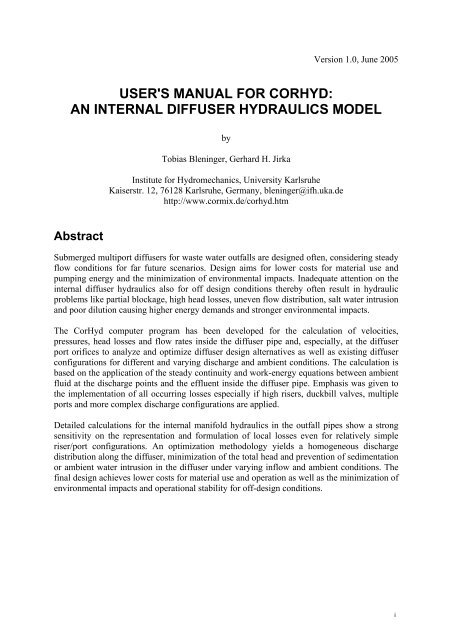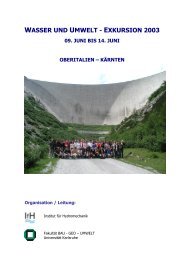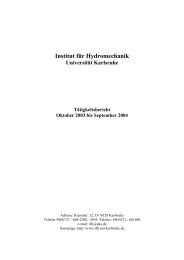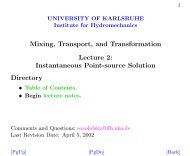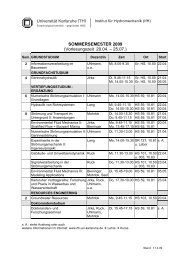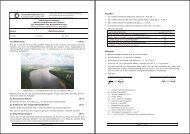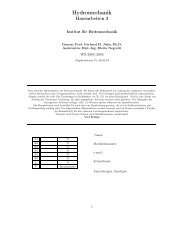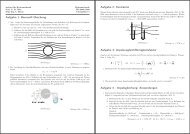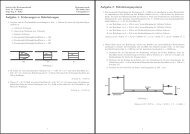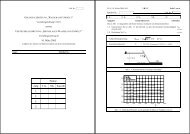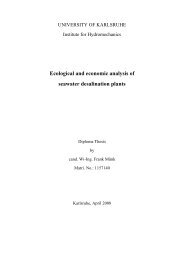user's manual for corhyd: an internal diffuser hydraulics model - IfH
user's manual for corhyd: an internal diffuser hydraulics model - IfH
user's manual for corhyd: an internal diffuser hydraulics model - IfH
You also want an ePaper? Increase the reach of your titles
YUMPU automatically turns print PDFs into web optimized ePapers that Google loves.
Version 1.0, June 2005<br />
USER'S MANUAL FOR CORHYD:<br />
AN INTERNAL DIFFUSER HYDRAULICS MODEL<br />
by<br />
Tobias Bleninger, Gerhard H. Jirka<br />
Institute <strong>for</strong> Hydromech<strong>an</strong>ics, University Karlsruhe<br />
Kaiserstr. 12, 76128 Karlsruhe, Germ<strong>an</strong>y, bleninger@ifh.uka.de<br />
http://www.cormix.de/<strong>corhyd</strong>.htm<br />
Abstract<br />
Submerged multiport <strong>diffuser</strong>s <strong>for</strong> waste water outfalls are designed often, considering steady<br />
flow conditions <strong>for</strong> far future scenarios. Design aims <strong>for</strong> lower costs <strong>for</strong> material use <strong>an</strong>d<br />
pumping energy <strong>an</strong>d the minimization of environmental impacts. Inadequate attention on the<br />
<strong>internal</strong> <strong>diffuser</strong> <strong>hydraulics</strong> also <strong>for</strong> off design conditions thereby often result in hydraulic<br />
problems like partial blockage, high head losses, uneven flow distribution, salt water intrusion<br />
<strong>an</strong>d poor dilution causing higher energy dem<strong>an</strong>ds <strong>an</strong>d stronger environmental impacts.<br />
The CorHyd computer program has been developed <strong>for</strong> the calculation of velocities,<br />
pressures, head losses <strong>an</strong>d flow rates inside the <strong>diffuser</strong> pipe <strong>an</strong>d, especially, at the <strong>diffuser</strong><br />
port orifices to <strong>an</strong>alyze <strong>an</strong>d optimize <strong>diffuser</strong> design alternatives as well as existing <strong>diffuser</strong><br />
configurations <strong>for</strong> different <strong>an</strong>d varying discharge <strong>an</strong>d ambient conditions. The calculation is<br />
based on the application of the steady continuity <strong>an</strong>d work-energy equations between ambient<br />
fluid at the discharge points <strong>an</strong>d the effluent inside the <strong>diffuser</strong> pipe. Emphasis was given to<br />
the implementation of all occurring losses especially if high risers, duckbill valves, multiple<br />
ports <strong>an</strong>d more complex discharge configurations are applied.<br />
Detailed calculations <strong>for</strong> the <strong>internal</strong> m<strong>an</strong>ifold <strong>hydraulics</strong> in the outfall pipes show a strong<br />
sensitivity on the representation <strong>an</strong>d <strong>for</strong>mulation of local losses even <strong>for</strong> relatively simple<br />
riser/port configurations. An optimization methodology yields a homogeneous discharge<br />
distribution along the <strong>diffuser</strong>, minimization of the total head <strong>an</strong>d prevention of sedimentation<br />
or ambient water intrusion in the <strong>diffuser</strong> under varying inflow <strong>an</strong>d ambient conditions. The<br />
final design achieves lower costs <strong>for</strong> material use <strong>an</strong>d operation as well as the minimization of<br />
environmental impacts <strong>an</strong>d operational stability <strong>for</strong> off-design conditions.<br />
i


